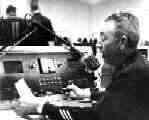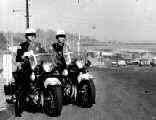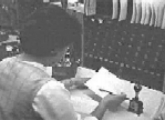    |
Copyright 1998, 2004 Harry Marnell |
|||
An Unofficial History
of the Los Angeles Police Department's Communications
Division |
NEW! Attention
radio buffs:
More detailed information
about LAPD's radio frequencies over the years on Page 2
LAPD
Audio and Video Recordings
|
|
|||||||||||||||||
|
|||||||||||||
"Calling all cars, calling all cars..." It should be remembered that the early 30's were the deepest of the depression years, and people didn't go out much. And while radios had become very popular, good radio programs had not yet been developed. Since police broadcasts were just above the AM broadcast band - LAPD was first on 1712 and then moved to 1730 kilocycles (kcs) - most home radios could tune them in. At night, the signal
of LAPD could be heard all across the country, even as
far as the east coast and Hawaii. In late 1945, LAPD
received a letter from the crew of the Navy Fleet Tug USS
Sarsi, stationed in the Aleutians, complaining that a
"loud, husky voice" was constantly interrupting
good programming they were listening to, reporting "a
stolen car in the Wilshire district, or trouble on Main
St.," and would they "tune that radio so it
won't reach Attu." (Los
Angeles Times, November 10, 1945) |
||||||||
|
||||||||
In the 1930s, Los Angeles Police experimented with a number of radio sets, both "home-brew" and from the handful of manufacturers, such as Sparton, Philco and Galvin/Motorola. This is the 1936 Motorola "Police Cruiser" mobile radio, a redesigned car radio preset to KGPL's 1712 kc frequency. A separate transmitter set was needed when two-way radios were introduced in 1938. |
||||||||
| The PR and Community Relations aspects of the public "listening in" weren't lost on the Department either. On November 29, 1933, William Robson's radio series "Calling All Cars" debuted on the CBS Radio Network. Chief James E. Davis was right there from the get-go, being an announcer and narrator for most of the early programs, many of which were based on actual L.A.P.D. cases. This series was designed for two purposes..."to sell 'Rio Grande' Gasoline and to tout the use of radios in police cars. |
|
|||||||
"As such, the stories revolved around just how fast squad cars can get to the scene of a crime now (1930s) as compared to a few years before, because of the radios ... and the increased speed and power of Rio Grande Gas! At times Davis sent subordinates to fill in for him, and many of the police officials that appeared as narrator, were just plain awful. They were awkward, missed cues and lines and mispronounced just about everything." ( - Jerry Haendiges, of the Vintage Radio Place) |
||||||||
| Years later, in 1950, less than a month into his historic 16-year term, Chief William H. Parker was asked to allow the use of actual LAPD radio calls in a proposed CBS television show called "Prowl Car." As Chief Davis had before him, Parker understood the widespread popularity of listening to the department's police calls on KMA367. He immediately consented to allowing the production company to record LAPD radio calls, his only condition being that the Department be allowed to review the film and police-call sound track before its airing. It is unknown if the TV show ever actually made it to the small-screen.
|
||||||||
The actual calls were seldom broadcast over the radio however, as the fire department remained skeptical for years about the dependability of two-way radios. Instead, the chiefs were simply told to "Phone Westlake (or Coldwater)." They carried telephone handsets in their cars, and would stop at the nearest fire-alarm box (frequently co-located with the police "Gamewells"), plug in, and receive their information from the fire department dispatcher. It wasn't until 1946 that LAFD's engines and trucks became equipped with two-way radios, in the 33-megacycle band, which they used well into the 1980s. |
||
|
*KMA367 was the FCC callsign for most of LAPD's radio transmitters from 1949 to the early 1980s, when the UHF-band "ROVER" radio frequencies went into operation. This included the "AM" band frequencies heard across the country and the VHF frequencies which followed them. Because of the wide coverage on the AM band, and its use on such TV shows as "Dragnet" and "Adam-12," KMA367 will probably be associated with the Los Angeles Police Department for years to come. There are still a handful of special-use frequencies with those call-letters, but the booming "KMA367" on the dispatch channels has been replaced with a recorded "KJC625." |
|
|
Then click on one of these links, print it out, and take it to work with you tomorrow... |
| Dispatch Procedures & Forms | NEW LAPD DISPATCH CENTERS | LAPD & Dispatching LINKS |
| What is a SIGALERT ?? | Photo Gallery |